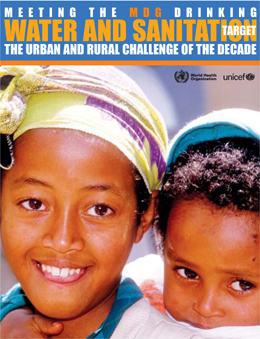|
 This report provides estimates of drinking water and sanitation coverage in 2004, by country and MDG region. It shows how many people have gained access since the MDG baseline year (1990) and identifies the challenges to meet the MDG drinking water and sanitation target over the coming decade. It compares progress towards the target, identifying which regions are on track, which are making progress but where progress is insufficient to reach the target, and which are not on track. With ever changing urban/rural population dynamics, JMP has analyzed different challenges for urban and rural areas, including the inequity between urban and rural areas, the emerging challenges of the increasing urban population growth, and the low coverage in rural areas. This report provides estimates of drinking water and sanitation coverage in 2004, by country and MDG region. It shows how many people have gained access since the MDG baseline year (1990) and identifies the challenges to meet the MDG drinking water and sanitation target over the coming decade. It compares progress towards the target, identifying which regions are on track, which are making progress but where progress is insufficient to reach the target, and which are not on track. With ever changing urban/rural population dynamics, JMP has analyzed different challenges for urban and rural areas, including the inequity between urban and rural areas, the emerging challenges of the increasing urban population growth, and the low coverage in rural areas.The report analyses how access to drinking water and sanitation services is evolving, looking intothe trends in urban and rural areas and how these are related to the likelihood of achieving the MDG drinking water and sanitation target. It highlights the efforts to be exerted in rural areas where there are billions of unserved people against a background of almost static population growth, and contrasts this with the efforts required in urban areas where, though coverage is high, rapid urbanization is under way. The report also compares projected coverage in 2015, based on the 1990–2004 trend, with the MDG drinking water and sanitation target. The statistics presented here were obtained from users of services (rather than providers of services) and thus are not affected by differences in definitions of access from country to country or political influence in presenting coverage data. The JMP data are thus likely to be more reliable and more comparable than data from national official reports. Because of retroactive adjustments to reflect new and more accurate data, coverage figures in previous JMP reports are superseded by those given in this report. Post Date : 07 Desember 2007 |